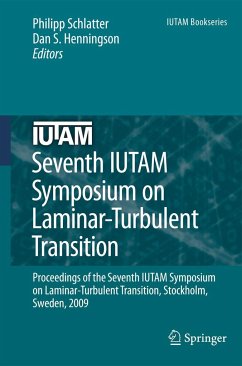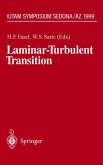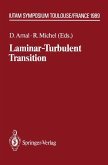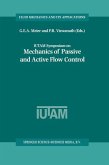This text contains 110 papers from presentations made during the seventh IUTAM symposium on laminar-turbulent transition. They cover the state-of-the-art on many topics related to the dynamics of transition from laminar to turbulent flows.
The origins of turbulent ?ow and the transition from laminar to turbulent ?ow are the most important unsolved problems of ?uid mechanics and aerodynamics. - sides being a fundamental question of ?uid mechanics, there are numerous app- cations relying on information regarding transition location and the details of the subsequent turbulent ?ow. For example, the control of transition to turbulence is - pecially important in (1) skin-friction reduction of energy ef?cient aircraft, (2) the performance of heat exchangers and diffusers, (3) propulsion requirements for - personic aircraft, and (4) separation control. While considerable progress has been made in the science of laminar to turbulent transition over the last 30 years, the c- tinuing increase in computer power as well as new theoretical developments are now revolutionizing the area. It is now starting to be possible to move from simple 1D eigenvalue problems in canonical ?ows to global modes in complex ?ows, all - companied by accurate large-scale direct numerical simulations (DNS). Here, novel experimental techniques such as modern particle image velocimetry (PIV) also have an important role. Theoretically the in?uence of non-normality on the stability and transition is gaining importance, in particular for complex ?ows. At the same time the enigma of transition in the oldest ?ow investigated, Reynolds pipe ?ow tran- tion experiment, is regaining attention. Ideas from dynamical systems together with DNS and experiments are here giving us new insights.
The origins of turbulent ?ow and the transition from laminar to turbulent ?ow are the most important unsolved problems of ?uid mechanics and aerodynamics. - sides being a fundamental question of ?uid mechanics, there are numerous app- cations relying on information regarding transition location and the details of the subsequent turbulent ?ow. For example, the control of transition to turbulence is - pecially important in (1) skin-friction reduction of energy ef?cient aircraft, (2) the performance of heat exchangers and diffusers, (3) propulsion requirements for - personic aircraft, and (4) separation control. While considerable progress has been made in the science of laminar to turbulent transition over the last 30 years, the c- tinuing increase in computer power as well as new theoretical developments are now revolutionizing the area. It is now starting to be possible to move from simple 1D eigenvalue problems in canonical ?ows to global modes in complex ?ows, all - companied by accurate large-scale direct numerical simulations (DNS). Here, novel experimental techniques such as modern particle image velocimetry (PIV) also have an important role. Theoretically the in?uence of non-normality on the stability and transition is gaining importance, in particular for complex ?ows. At the same time the enigma of transition in the oldest ?ow investigated, Reynolds pipe ?ow tran- tion experiment, is regaining attention. Ideas from dynamical systems together with DNS and experiments are here giving us new insights.








